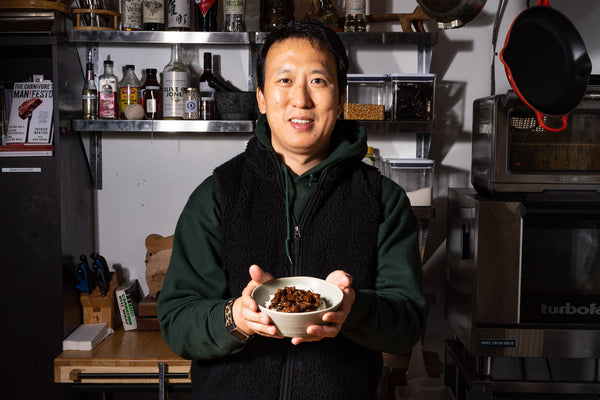
How to make Lu Rou Fan with Chef Richard Ho of Ho Foods
Rich Ho is one of the most respected and well liked chefs in NYC. His menu derives from his native Taiwan where he learned the art of the cuisine from family, friends and other chefs. His Ho Foods in the East Village is a tiny jewel of a restaurant serving up some of the best beef noodle soup, scallion pancakes, and lu rou fan which is featured here.
Hard to know when this dish started, since almost every culture has a braised pork dish (if they eat pork). But probably like other dishes like this, came from some butcher trying to figure out how to cook up the trim. For as long as I can remember, this dish has become a national hobby in Taiwan. There’s a hunt to find the best, or the oldest, etc. Every shop does it a bit differently (isn’t that the case with most everything though).
Some main players for flavor in the dish are shallots (really nicely fried shallots), rock sugar, soy & five spice.
While pork belly is common, pork neck or shoulder can be used as well. Ground pork is a cheat that saves a bunch of time, but the dish really doesn’t come out the same. Still delicious! Grandma used to use ground pork often, no knock on her as she made another 7 dishes with dinner for almost every meal too.
This is also a dish that can be used for different things, at different stages. The pieces of meat are more defined to begin with, but after reheating (it’s something you usually make a pot of, like Sunday gravy) it breaks down a bit more, making it useful for other dishes.
So while we will provide a recipe, maybe there’s a few techniques or ideas that will help make cooking more relatable and delicious.

Tips:
1. Blanching the pork belly. Why do people blanch meat all the time, aren’t we cooking it already?
Blanching helps kill off any surface bacteria in the meat, gets rid of a little bit of the game-e-ness, and also makes it easier to slice.
2. Braising can be simple or complicated. While simple is delicious and used here, we’re gonna give you something else to think about that you can apply to all slow cooking.
When cooking things for a long time, we are looking to break down collagen into gelatin. This just takes a while. However, the longer you cook, the more the actual meat fibers will dry out. Long story short meat fibers and collagen cook at different times.
The simple solve for this is just cooking at a low temp, (160f to 180f). This makes it so both break down to a good and tasty place.
Slightly more complicated way is to separate the skin completely. Then you can still braise the meat til exactly where you want it, and break down the collagen in the skin to exactly where you want it. Another benefit is you can render out a little bit of fat, use it for cooking or maybe scallion pancakes!
3. We’re always try to add little extra layers of flavor. When it comes to soy sauce, getting that high heat sizzles adds just a little tastiness. With the sugar, (not traditional at all) but you could caramelize it to add a little depth. Small little things make the end product just a tad tastier.
4. Rice. Way too much to talk about, but some short grain (not glutinous) “sticky” rice like koshihikari is a nice start. While I usually like chewy fluffy rice, with this dish I like a rice that is slightly dry and will break apart a little easier than koshihikari. Anyways, this is just me being picky. Most white rice will be just fine, brown rice just won’t be the same. This is a little treat, so maybe a little white rice is ok.
5. Around here, you mostly you get a little slice of pickled daikon on the side to help break up the richness. Some shops I’ve seen a bottle a sweet chili vinegar on the table to do something similar. Now I think of it, it’s kinda like the daikon pickling liquid diluted a bit without the daikon.
6. Soy sauce, so much to talk about! Another time. But if you only got one, just use one. Adjust your recipes to the saltiness of your soy, they are almost all different. Remember light doesn’t mean less salt, it usually has more because it’s meant to season without adding as much color. Dark usually has less since it’s for color. Lite is a completely different thing. Aged can vary greatly! Most soy sauce you buy is just salty water with caramel color and flavor boosters. Go to Yunhai and get some good stuff once in a while.
Ingredients:
- 1kg skin on pork belly
- 45g rock sugar (hard to measure rock sugar in tablespoons, but about 2) (Whatever sugar you have on hand works too)
- 200g fried shallots
- 100g dark soy
- 100g aged soy
- 100g rice wine or beer
- 200g pork stock (optional)
- 5g five spice
- 3 grams white pepper
- Dash of orange rind (optional)
- Your favorite pickle
Preparation:
- Slice belly into strips (like bacon) then blanch and slice into thin strips (lardons)
- Saute pork belly until you get a tiny bit of color, pour out any liquid that comes from this step that doesn’t evaporate.
- Add shallots, soy (remember to pour it from the side), wine, 5 spice and white pepper.
- Bring down to a low simmer for about 40 minute lid on, 20 minutes lid off.
- Check to see the skin has broken down, it should look nice and shiny, and be tender to the bit, but not melt immediately. If it needs a little more time, or the sauce looks a bit thin, cook it some more to reduce.
- Microplane a little orange zest to add a little extra something (if you would like)
- Serve over freshly made fluffy white rice. With a side of your favorite pickles.
This sauce can be used to flavor quickly blanched vegetables. Try blanching lettuce! Tastier than you think! Or maybe you already think that way.
You can also use this sauce like a meat sauce for sauté noodle dish. Stir frying some noodles with this sauce, garlic chives, and bean sprout is an easy and tasty dish.
There’s also a dish that uses this in a noodle soup. It’s not quite the same but very similar to a very cooked down version of this. You make a noodle soup with wheat or rice noodles in a pork broth, and a spoonful of this sauce with a few other accoutrements.
